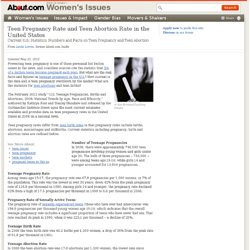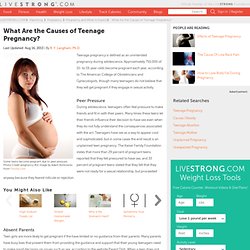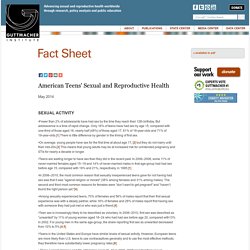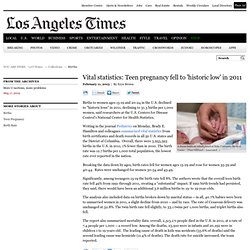

Teen Pregnancy Rate, Teen Abortion Rate in U.S. Updated May 25, 2012 Preventing teen pregnancy is one of those perennial hot button issues in the news, and countless sources cite the statistic that 3/4 of a million teens become pregnant each year .

But what are the real facts and figures on teenage pregnancy in the U.S. ? How current is the data and is teen pregnancy overblown by the media? What are the statistics for teen abortions and teen births? The February 2012 study "U.S. What Are The Causes Of Teenage Pregnancy? Teenage pregnancy is defined as an unintended pregnancy during adolescence.

Approximately 750,000 of 15- to 19-year-olds become pregnant each year, according to The American College of Obstetricians and Gynecologists, though many teenagers do not believe that they will get pregnant if they engage in sexual activity. During adolescence, teenagers often feel pressure to make friends and fit in with their peers. Many times these teens let their friends influence their decision to have sex even when they do not fully understand the consequences associated with the act. Teenagers have sex as a way to appear cool and sophisticated, but in some cases the end result is an unplanned teen pregnancy. The Kaiser Family Foundation states that more than 29 percent of pregnant teens reported that they felt pressured to have sex, and 33 percent of pregnant teens stated that they felt that they were not ready for a sexual relationship, but proceeded anyway because they feared ridicule or rejection.
Leymah Gbowee: Unlock the intelligence, passion, greatness of girls. Facts on American Teens' Sexual and Reproductive Health. May 2014 •Fewer than 2% of adolescents have had sex by the time they reach their 12th birthday.

But adolescence is a time of rapid change. Only 16% of teens have had sex by age 15, compared with one-third of those aged 16, nearly half (48%) of those aged 17, 61% of 18-year-olds and 71% of 19-year-olds.[1] There is little difference by gender in the timing of first sex. •On average, young people have sex for the first time at about age 17, [2] but they do not marry until their mid-20s.[3] This means that young adults may be at increased risk for unintended pregnancy and STIs for nearly a decade or longer.
•Teens are waiting longer to have sex than they did in the recent past. •In 2006–2010, the most common reason that sexually inexperienced teens gave for not having had sex was that it was “against religion or morals" (38% among females and 31% among males). •Teen sex is increasingly likely to be described as voluntary. . • Contraceptive use at first sex has increased over time. STIs. Teen Pregnancy Statistics - Teen Pregnancy. Even though the teen pregnancy rate has declined over the past few decades, the fact of the matter is that the United States has the highest teen pregnancy rate of the Western industrialized world.

It is true that the teen pregnancy and birth rate was much higher prior to 1980 (and especially in the 1950s and 1960s), but at the time young women were getting married and having children before the age of 20. Most of the teen pregnancies occurring before 1980 were to married women; now most of today's teen mothers are unwed.
Here are some more interesting teen pregnancy statistics: How many teens are becoming pregnant? Contraception Editorial January 2008: Reducing Unintended Pregnancy in the United States. By: James Trussell and L.L.

Wynn Almost half (49%) of all pregnancies in the United States are unintended: There were 3.1 million in 2001 alone, the last year for which data are available.1 There has been no change in the recent past; these statistics were the same in 1994.2 One of every two women aged 15–44 in the United States has experienced at least one unintended pregnancy.2 What is responsible for the unacceptably high incidence of unintended pregnancy and what can be done to reduce this incidence? Information on levels and trends in contraceptive use in the United States is based on the National Surveys of Family Growth (NSFG), periodic surveys conducted by the National Center for Health Statistics in which women ages 15–44 are interviewed about topics related to childbearing, family planning and maternal and child health.
Among the 61.6 million women of reproductive age in 2002, about 62% (38.1 million) were using some method of contraception, according to the 2002 NSFG. Vital statistics: Teen pregnancy fell to 'historic low' in 2011. A doctor holds an infant's hand at Duke University Medical Center… (Stan Gilliland / Associated…) Births to women ages 15-19 and 20-24 in the U.S. declined to "historic lows" in 2011, declining to 31.3 births per 1,000 women, said researchers at the U.S.

Centers for Disease Control's National Center for Health Statistics. Teen contraception decision: Doctors say science trumps politics. Science trumped politics, but politics may still present problems for teens trying to purchase emergency contraception.

“A lot of stuff is going to happen over the next 30 days,” said Dr. Cora Breuner, a pediatric medicine specialist at the University of Washington. Breuner was reacting to a judge's decision Friday to overturn age restrictions on access to emergency contraception. U.S. District Judge Edward Korman called those restrictions by the Food and Drug Administration “politically motivated and scientifically unjustified.” “There is no serious health risk associated with use of Plan B as prescribed and intended, much less one that would make restrictions on distribution necessary for its safe use,” Korman wrote.